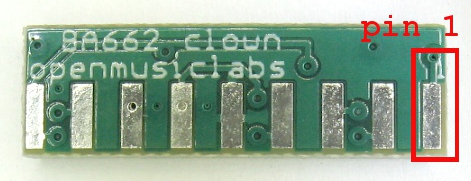BA662 Clone
About the BA662 Clone
The BA662 clone is a replica of the very rare BA662 OTA which was used by Roland in a number of their synthesizers and effects pedals from the 80's. The internal wiring of the BA662 was reverse engineered from an original part by applying external voltages and currents, and seeing how it responded. For example, you can find out how many transistors are at the top and bottom of the output stage by measuring the saturation voltages. From this it was found that they used Wilson current mirrors. Also, by measuring the current consumption under varying signal levels, the value of the emitter resistor on the buffer stage was found. A fair bit of the anaylsis was based on recollections from seeing a datasheet a long time ago, and the fact that OTA's have very similar topologies.
For a full description of how the BA662 works, check out our x0xb0x page.
Installation
To install the clone, just solder the 0.1" SIP header (or just some solid core wire) onto the pads on the back. Be sure that the header fits your holes before soldering it in place. Next, clean the flux off the back of the board where you soldered. Then solder the whole assembly into place on your PCB. Finally, clean the flux again near your PCB solder joints. It is very important to clean the flux off (rubbing alchohol works well) as the flux is conductive, and leakage currents on the order of 1uA can cause audible differences (especially near pin1).
To locate pin1, look on the back of the clone (the side with the header solder pads) and find the small number "1" at one end. This will be the end opposite the side that says "openmusiclabs".

Offset voltage
The BA662 Clone uses PMP4201 matched transistor pairs, which have a maximum offset voltage of 2mV and current matching of 98% minimum. This is probably better than the orginals, and why the originals had A and B variants. Its unclear what level they used to select between A and B, but it was probably around 1mV, as it would have been difficult to get higher precision back then (leading to a lot of B variants). Some synths required "selected" BA662A's, which were hand picked for even lower offset voltages. Of the 2 BA662A's we tested, one had an offset voltage of 250uV, and the other had an offset voltage of 30uV. The 30uV variant was from a TB-303, which used "selected" components. From testing on the initial batch of 100 BA662 Clones, the worst offset voltage was 500uV, with most being below 100uV.
Another source of offset error is from bias current differences between the matched pairs. The bias currents on both the original and the clone are approximately 150nA. This gives an offset of 150uV with a 1k source impedance. But, if both inputs draw the same amount, they cancel each other out (as long as the design has the same resistor at both inputs - which it should). So its only the difference between these currents that matter. This difference was 10nA on the non-"selected" BA662A, and below the meter threshold of 10nA for both the "selected" and clone variants. This would mean a less than 10uV offset voltage variation for 1k input impedances, and even lower for smaller input impedances (which are preferred for this reason, and lower noise).
Finally, there is offset in the output buffer. This shouldn't matter for most applications, but it does exist. The "selected" variant had a buffer offset of -5mV, the non-"selected" had an offset of +25mV, and the clone -8mV. This offset voltage is a strong function of the voltage on pin4 of the BA662 (the bias current pin). So if this is important, it can be trimmed out in a similar fashion to trimming out the input offset voltage.
Ultimately, the BA662 Clone is probably within spec for average BA662A's, and maybe 1 in 3 are within the "selected" range. Its hard to say exactly, not knowing what Roland's cutoffs were. The main drawback of the clone, is that the transistors are physically seperated, so temperature variations can cause bias drift. But, these should be fairly stable once installed and warmed up.
Comparison to AS662
After the release of the Alfa AS662, and noticing a few differences, i went back and tested a few things i left out in the orignal work. As the alfa part shows, there are emitter resistors on the input current mirror (Q1A,B). i measured around 500ohms, whereas the Alfa datasheet shows 400ohms, but this is within the margin of error of both my measurements, and thetolerance of internal resistors on ICs, so any value in that range is probably fine. i also tested the ratio of the current mirror on the buffer amp, and this is 1:1 (it is 2:1 on the BA6110). The Alfa datasheet shows two other differences: a collector resistor on the NPN in the buffer, and a cascode mirror for the sourcing mirror on the output. Both of these differences would be very hard to test for, and as a consequence would also have minor effects on any application of the BA662, so i didn't bother testing for them.
